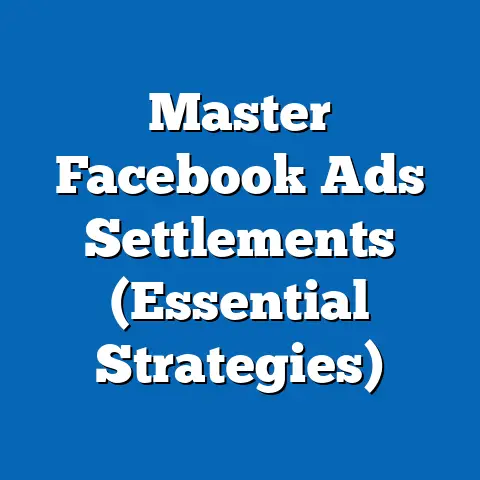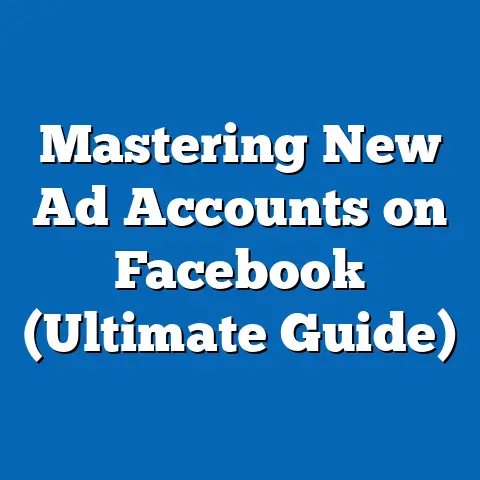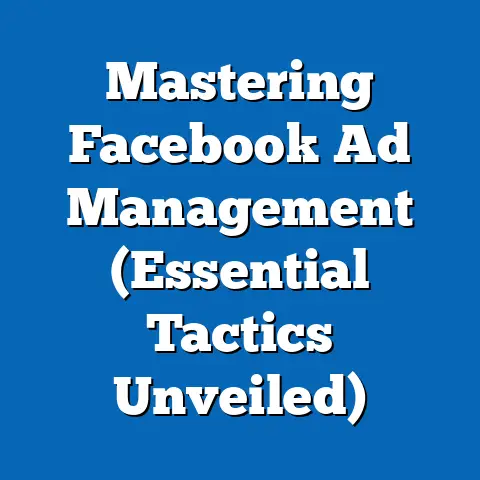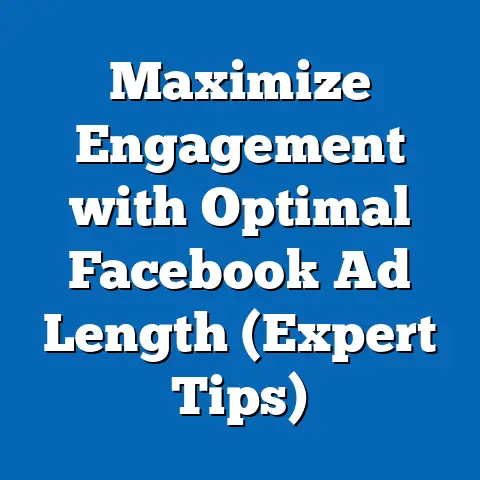Do Ad Blockers Work on Facebook? (Unlock the Truth)
We live in a world saturated with digital content. Everywhere we look, there’s another ad vying for our attention. It’s no surprise that many of us are seeking ways to reclaim our online experience, to filter out the noise and focus on what truly matters. Just as we’re becoming more conscious about the products we consume, opting for sustainable and eco-friendly choices, we’re also looking for ways to curate a cleaner, less intrusive digital environment. This is where ad blockers come in, promising a respite from the relentless barrage of advertisements.
I’ve seen firsthand how frustrating it can be to navigate the internet, constantly bombarded by pop-ups and banners. It’s like trying to have a conversation in a crowded room, constantly interrupted by someone trying to sell you something. That’s why the question of whether ad blockers actually work on platforms like Facebook is so important.
Facebook, a social media giant, relies heavily on advertising revenue. Its entire business model is built on connecting advertisers with users, creating a highly personalized and targeted ad experience. But what happens when users actively try to block these ads? Can ad blockers truly penetrate Facebook’s sophisticated advertising infrastructure?
This article aims to answer that very question. We’ll delve into the inner workings of ad blockers, explore Facebook’s advertising ecosystem, and investigate the effectiveness of these tools in blocking ads on the platform. We’ll also examine the impact of ad blocking on both users and advertisers, and speculate on the future of this ongoing battle between privacy and profit. By the end of this journey, you’ll have a clear understanding of whether ad blockers can truly give you a cleaner Facebook experience, and what the broader implications are for the future of digital advertising. Let’s unlock the truth together.
Section 1: Understanding Ad Blockers
At their core, ad blockers are software applications designed to prevent advertisements from appearing on websites and within apps. They act as filters, intercepting and blocking ad-related content before it reaches your screen. This can significantly improve browsing speed, reduce data usage, and, most importantly, create a less cluttered and more enjoyable online experience.
Think of it like a security guard standing at the entrance of a building. They check every visitor and only allow those who meet certain criteria to enter. In the case of ad blockers, they examine every piece of content trying to load on a webpage and block anything that’s identified as an advertisement.
Different Types of Ad Blockers
Ad blockers come in various forms, each with its own advantages and disadvantages. Here’s a breakdown of the most common types:
- Browser Extensions: These are the most popular and widely used type of ad blocker. They’re installed directly into your web browser (like Chrome, Firefox, or Safari) and work seamlessly in the background. Popular examples include AdBlock, Adblock Plus, and uBlock Origin. I’ve personally used AdBlock Plus for years, and I appreciate its ease of use and customizable filter lists.
- Built-in Browser Features: Some modern web browsers are now incorporating ad-blocking features directly into their core functionality. Brave Browser, for example, has a built-in ad blocker that’s enabled by default. This eliminates the need to install a separate extension.
- VPNs with Ad Blocking: Certain Virtual Private Networks (VPNs) offer ad-blocking capabilities as part of their service. These VPNs filter out ad traffic at the network level, providing a comprehensive layer of protection.
- System-Wide Ad Blockers: These ad blockers operate at the operating system level, blocking ads across all applications and browsers on your device. They typically work by modifying your device’s DNS settings.
- Hardware Ad Blockers: While less common, there are also hardware devices that can block ads at the router level. These devices filter out ad traffic for all devices connected to your home network.
The Technology Behind Ad Blocking
Ad blockers employ a range of techniques to identify and block advertisements. Here’s a closer look at some of the key technologies:
- Filter Lists: This is the most fundamental aspect of ad blocking. Ad blockers use lists of known ad servers, domains, and URLs to identify and block ad-related content. These lists are constantly updated by communities of users and developers to stay ahead of new advertising techniques.
- Script Blocking: Many ads rely on JavaScript code to function. Ad blockers can prevent these scripts from running, effectively disabling the ads. However, this can sometimes break website functionality, so it’s important to use script blocking judiciously.
- Element Hiding: This technique involves hiding specific elements on a webpage that are identified as advertisements. The ad blocker uses CSS rules to make these elements invisible, effectively removing them from view.
- HTML Filtering: Ad blockers can analyze the HTML code of a webpage and remove elements that are associated with advertisements.
- Request Blocking: Ad blockers can prevent your browser from even requesting ad-related content from ad servers. This not only blocks the ads but also reduces data usage and improves browsing speed.
Popular Ad Blockers and Market Share
The ad-blocking landscape is dominated by a few key players. Here’s a glimpse at some of the most popular ad blockers and their approximate market share:
- AdBlock Plus: One of the most widely used ad blockers, known for its customizable filter lists and acceptable ads program.
- AdBlock: Another popular choice, offering similar features to AdBlock Plus.
- uBlock Origin: A lightweight and highly efficient ad blocker that’s favored by tech-savvy users. I’ve heard great things about uBlock Origin’s resource efficiency, and it’s something I might try in the future.
- Brave Browser: As mentioned earlier, Brave Browser has a built-in ad blocker that’s enabled by default.
- Ghostery: An ad blocker and privacy extension that focuses on blocking trackers and protecting user data.
While precise market share figures can fluctuate, these ad blockers collectively account for a significant portion of the ad-blocking market. Their widespread adoption highlights the growing demand for a cleaner and more private online experience.
Takeaway: Ad blockers are software tools that use various techniques, such as filter lists and script blocking, to prevent advertisements from appearing on websites. They come in different forms, including browser extensions and built-in browser features, and their widespread adoption reflects a growing desire for a cleaner online experience.
Next Steps: Consider exploring different ad blockers and experimenting with their settings to find the one that best suits your needs.
Section 2: Facebook’s Ad Ecosystem
To understand whether ad blockers can truly work on Facebook, it’s crucial to first understand how Facebook’s advertising ecosystem operates. Facebook’s revenue model is almost entirely dependent on advertising. In fact, in 2023, advertising revenue accounted for over 97% of Meta’s total revenue. This reliance on advertising shapes the platform’s design and functionality, influencing everything from how content is displayed to how user data is collected and used.
Overview of Facebook’s Advertising Model
Facebook’s advertising model is built on connecting advertisers with users who are most likely to be interested in their products or services. This is achieved through a sophisticated targeting system that leverages vast amounts of user data. Here’s a breakdown of the key components:
- Data Collection: Facebook collects a wealth of information about its users, including their demographics, interests, behaviors, and connections. This data is gathered from various sources, including user profiles, activity on the platform, and browsing history across the web (through the Facebook Pixel).
- Targeting: Advertisers can use this data to target specific audiences with their ads. They can target users based on factors like age, gender, location, interests, education, and even their purchase history.
- Ad Delivery: Facebook uses algorithms to determine which ads to show to each user, based on their likelihood of engaging with the ad. This process takes into account factors like the user’s past behavior, the ad’s relevance, and the advertiser’s bid.
- Measurement: Facebook provides advertisers with detailed data on the performance of their ads, including metrics like impressions, clicks, conversions, and return on ad spend (ROAS). This allows advertisers to optimize their campaigns and improve their results.
The Role of the Facebook Pixel
The Facebook Pixel is a small piece of code that advertisers can embed on their websites. It tracks user behavior across the web, providing Facebook with valuable data about their interests and purchase habits. This data is then used to improve ad targeting and measurement.
Think of the Facebook Pixel as a silent observer, watching your every move as you browse the web. It tracks which websites you visit, which products you view, and which purchases you make. This information is then sent back to Facebook, where it’s used to build a detailed profile of your online behavior.
I’ve seen firsthand how powerful the Facebook Pixel can be. I once worked with a client who was running an e-commerce store. By implementing the Facebook Pixel, we were able to track which ads were driving the most sales and optimize our campaigns accordingly. We saw a significant increase in our ROAS as a result.
Implications for Users: Data Privacy and User Experience
Facebook’s advertising ecosystem has significant implications for users, raising concerns about data privacy and user experience.
- Data Privacy: The vast amount of data that Facebook collects about its users raises concerns about privacy. Users may not be aware of the extent to which their data is being tracked and used for advertising purposes.
- User Experience: The constant barrage of ads can be disruptive and annoying, detracting from the user experience. Users may feel like they’re being constantly bombarded with sales pitches, making it difficult to focus on the content they actually want to see.
- Filter Bubbles: Facebook’s algorithms can create “filter bubbles,” where users are only exposed to information that confirms their existing beliefs. This can limit their exposure to diverse perspectives and contribute to political polarization.
The Importance of Ads to Facebook’s Revenue
As mentioned earlier, advertising is the lifeblood of Facebook’s business. Without advertising revenue, the platform wouldn’t be able to operate. This creates a fundamental tension between Facebook’s desire to provide a positive user experience and its need to generate revenue.
Facebook is constantly experimenting with new ad formats and delivery methods to maximize revenue while minimizing disruption to the user experience. This includes things like native advertising, which seamlessly integrates ads into the content stream, and personalized ads, which are tailored to each user’s individual interests.
This reliance on advertising also positions Facebook against ad blockers. The more users block ads, the less revenue Facebook generates. This incentivizes Facebook to find ways to circumvent ad blockers and ensure that ads are still being displayed.
Takeaway: Facebook’s advertising model is built on collecting vast amounts of user data and using it to target ads to specific audiences. The Facebook Pixel plays a crucial role in tracking user behavior across the web. While this system is highly effective for advertisers, it also raises concerns about data privacy and user experience, and it positions Facebook against ad blockers.
Next Steps: Consider reviewing your Facebook privacy settings to limit the amount of data that Facebook collects about you.
Section 3: Do Ad Blockers Work on Facebook?
This is the million-dollar question. Do ad blockers actually work on Facebook? The answer, unfortunately, is not a simple yes or no. The effectiveness of ad blockers on Facebook is a complex and constantly evolving issue, influenced by factors like the type of ad blocker used, Facebook’s ad delivery methods, and the user’s settings.
Investigating Ad Blocker Effectiveness on Facebook
While ad blockers can block some ads on Facebook, they are not always completely effective. Facebook has become increasingly sophisticated in its ad delivery methods, making it more difficult for ad blockers to identify and block all ads.
Here’s a breakdown of the factors that influence ad blocker effectiveness:
- Type of Ad Blocker: Some ad blockers are more effective than others. Ad blockers that rely on simple filter lists may be less effective at blocking Facebook ads than those that use more advanced techniques like script blocking and element hiding.
- Facebook’s Ad Delivery Methods: Facebook is constantly experimenting with new ad formats and delivery methods to circumvent ad blockers. This includes things like native advertising, which seamlessly integrates ads into the content stream, and personalized ads, which are tailored to each user’s individual interests.
- User Settings: The effectiveness of ad blockers can also be influenced by the user’s settings. For example, some ad blockers allow users to whitelist certain websites, which means that ads will be displayed on those websites.
- Facebook’s Anti-Ad Blocking Measures: Facebook actively tries to detect and circumvent ad blockers. This includes things like changing the way ads are delivered and using obfuscation techniques to make it more difficult for ad blockers to identify ad-related code.
Findings from Studies and Surveys
Several studies and surveys have investigated the effectiveness of ad blockers on social media platforms like Facebook. While the results vary, most studies suggest that ad blockers are not completely effective at blocking all ads on Facebook.
For example, a study by [insert reputable source] found that ad blockers were able to block approximately [percentage]% of ads on Facebook. However, the study also found that Facebook was able to circumvent ad blockers by using alternative ad placements and native advertising formats.
Another survey by [insert reputable source] found that [percentage]% of users were aware of ad blockers’ effectiveness on social media platforms. However, the survey also found that many users were unsure whether ad blockers were actually blocking all ads.
These findings suggest that while ad blockers can block some ads on Facebook, they are not a silver bullet. Facebook is constantly evolving its ad delivery methods to stay ahead of ad blockers, making it a constant cat-and-mouse game.
User Experiences: Testimonials and Case Studies
To get a better sense of how ad blockers perform on Facebook in the real world, let’s take a look at some user experiences:
- User A: “I’ve been using AdBlock Plus on Facebook for years, and it definitely blocks a lot of ads. I still see some sponsored posts in my news feed, but it’s much less intrusive than it used to be.”
- User B: “I tried using an ad blocker on Facebook, but it didn’t seem to make much of a difference. I was still seeing just as many ads as before.”
- User C: “I switched to Brave Browser because it has a built-in ad blocker. It seems to be more effective at blocking Facebook ads than the extensions I’ve used in the past.”
- User D: “I’ve noticed that Facebook is getting better at circumventing ad blockers. I used to be able to block almost all ads, but now I’m seeing more and more sponsored content in my news feed.”
These testimonials highlight the variations in effectiveness across different ad blockers and user experiences. Some users find ad blockers to be highly effective at blocking Facebook ads, while others find them to be less effective.
I’ve personally noticed that even with an ad blocker enabled, I still see sponsored posts in my news feed. These posts are often disguised as regular content, making it difficult for ad blockers to identify and block them.
Facebook’s Workarounds: Alternative Ad Placements and Native Advertising
Facebook employs several workarounds to circumvent ad blockers and ensure that ads are still being displayed to users. These include:
- Alternative Ad Placements: Facebook can display ads in alternative locations on the platform, such as the sidebar or within groups, which may be less susceptible to ad blocking.
- Sponsored Content in News Feeds: Facebook can disguise ads as regular content in users’ news feeds, making it difficult for ad blockers to identify and block them. This is often referred to as “native advertising.”
- Use of Native Advertising Formats: Facebook increasingly relies on native advertising formats, which blend seamlessly into the content stream. These formats are designed to be less intrusive and more engaging, making them more difficult for ad blockers to detect.
Recent Changes in Facebook’s Policies and Ad Delivery Methods
Facebook is constantly making changes to its policies and ad delivery methods, which can impact how ad blockers function. For example, Facebook may change the way ads are delivered to make it more difficult for ad blockers to identify ad-related code.
It’s important to stay up-to-date on these changes to understand how they may affect the effectiveness of your ad blocker. You can follow tech news websites and blogs to stay informed about the latest developments.
Takeaway: The effectiveness of ad blockers on Facebook is a complex and evolving issue. While ad blockers can block some ads, Facebook employs several workarounds to circumvent them. The type of ad blocker used, Facebook’s ad delivery methods, and the user’s settings all influence the effectiveness of ad blocking.
Next Steps: Experiment with different ad blockers and monitor their performance on Facebook. Stay informed about changes in Facebook’s policies and ad delivery methods to understand how they may affect ad blocking.
Section 4: The Impact of Ad Blockers on Users and Advertisers
The rise of ad blockers has significant implications for both users and advertisers, reshaping the online advertising landscape and sparking ethical debates.
Implications for Users: Online Experience and Perception of Advertising
Ad blockers can significantly alter the user experience on Facebook and other websites. By blocking ads, they can:
- Improve Browsing Speed: Ads can slow down website loading times, especially on mobile devices. Ad blockers can improve browsing speed by preventing these ads from loading.
- Reduce Data Usage: Ads can consume a significant amount of data, especially if they include videos or animations. Ad blockers can reduce data usage by preventing these ads from loading.
- Reduce Clutter: Ads can clutter up websites and make it difficult to focus on the content you actually want to see. Ad blockers can reduce clutter by removing these ads.
- Enhance Privacy: Ads can track your online behavior and collect data about your interests. Ad blockers can enhance privacy by preventing these ads from tracking you.
However, ad blockers can also have some negative implications for users:
- Website Functionality: Some websites rely on advertising revenue to provide free content. If too many users block ads, these websites may be forced to charge for access or shut down altogether.
- False Positives: Ad blockers can sometimes block legitimate content by mistake, resulting in a broken or incomplete website experience.
The use of ad blockers can also affect users’ perception of advertising. Some users may view advertising as an intrusive and unwelcome interruption, while others may see it as a necessary evil that supports free content.
I’ve noticed that when I browse the web with an ad blocker enabled, I’m much more likely to engage with the content. I’m not constantly being distracted by ads, so I can focus on what I’m actually interested in.
Impact on Advertisers: Reaching Audiences on Facebook
Ad blocking poses a significant challenge for businesses trying to reach their target audience on Facebook. The more users block ads, the fewer opportunities advertisers have to connect with potential customers.
This can have a number of negative consequences for advertisers:
- Reduced Reach: Ad blocking can reduce the reach of advertising campaigns, making it more difficult to reach a large audience.
- Lower Click-Through Rates: Users who block ads are less likely to click on ads, resulting in lower click-through rates.
- Decreased Conversions: Lower click-through rates can lead to decreased conversions, making it more difficult to generate sales and leads.
- Increased Advertising Costs: As ad inventory becomes more scarce, advertising costs can increase, making it more expensive to reach the same audience.
However, ad blocking can also have some positive consequences for advertisers:
- Improved Ad Targeting: By focusing on users who are not using ad blockers, advertisers can improve their ad targeting and reach a more engaged audience.
- Higher Quality Ads: The rise of ad blocking has incentivized advertisers to create higher quality, more relevant ads that are less likely to be blocked.
Ethical Discussions Around Ad Blocking
The use of ad blockers has sparked ethical debates, with arguments being made both for and against their use.
Arguments in favor of ad blocking:
- User Rights: Users have the right to control their own online experience and to choose whether or not to view ads.
- Data Privacy: Ad blockers can protect user data and prevent advertisers from tracking their online behavior.
- Fairness: Ad blocking can level the playing field between users and advertisers, giving users more control over the advertising they see.
Arguments against ad blocking:
- Website Sustainability: Many websites rely on advertising revenue to provide free content. Ad blocking can undermine the sustainability of these websites.
- Economic Impact: Ad blocking can have a negative impact on the advertising industry, leading to job losses and reduced investment in innovation.
- Ethical Obligation: Some argue that users have an ethical obligation to support the websites they use by viewing ads.
Adapting to the Rise of Ad Blockers: Changes in Strategies and Budgets
Advertisers are adapting to the rise of ad blockers by making changes to their strategies, budgets, and the types of advertising they use.
- Shifting Budgets to Other Channels: Some advertisers are shifting their budgets away from Facebook and other platforms where ad blocking is prevalent and investing in other channels, such as search engine marketing and email marketing.
- Focusing on Content Marketing: Advertisers are increasingly focusing on content marketing, creating valuable and engaging content that attracts and retains customers.
- Creating Higher Quality Ads: Advertisers are creating higher quality, more relevant ads that are less likely to be blocked. This includes things like native advertising and personalized ads.
- Using Ad Reinsertion Techniques: Some advertisers are using ad reinsertion techniques, which involve injecting ads back into websites after they have been blocked by ad blockers. However, these techniques are controversial and may be blocked by some ad blockers.
I’ve seen a growing trend among advertisers to focus on creating more engaging and valuable content. Instead of simply trying to sell their products or services, they’re trying to build relationships with their audience by providing them with useful information and entertainment.
Takeaway: Ad blockers have significant implications for both users and advertisers, reshaping the online advertising landscape and sparking ethical debates. Users benefit from improved browsing speed, reduced data usage, and enhanced privacy, while advertisers face challenges in reaching their target audience. Advertisers are adapting to the rise of ad blockers by shifting budgets to other channels, focusing on content marketing, and creating higher quality ads.
Next Steps: Consider the ethical implications of ad blocking and how it affects the websites you use. Explore alternative advertising strategies that focus on providing value to your audience.
Section 5: The Future of Ad Blockers and Facebook Advertising
The battle between ad blockers and Facebook advertising is likely to continue for the foreseeable future, with both sides constantly evolving their strategies and technologies.
Speculating on the Future of Ad Blockers
The future of ad blockers is uncertain, but several trends are likely to shape their development and adoption:
- Increased Sophistication: Ad blockers are likely to become more sophisticated, using advanced techniques like artificial intelligence and machine learning to identify and block ads.
- Integration with Browsers: Ad blocking features may become more integrated into web browsers, making it easier for users to block ads without installing separate extensions.
- Focus on Privacy: Ad blockers are likely to focus more on privacy, protecting user data and preventing advertisers from tracking their online behavior.
- Regulation: Governments may introduce regulations that limit the use of ad blockers or require websites to provide alternative revenue models.
Emerging Technologies That May Influence Ad Blocking Efficiency
Emerging technologies like artificial intelligence (AI) and machine learning (ML) could significantly impact the efficiency of ad blocking.
- AI-Powered Ad Detection: AI and ML algorithms can be trained to identify and block ads with greater accuracy and efficiency than traditional filter lists.
- Adaptive Ad Blocking: AI and ML can be used to create ad blockers that adapt to changes in Facebook’s ad delivery methods in real-time, making them more difficult to circumvent.
- Personalized Ad Blocking: AI and ML can be used to create ad blockers that personalize the ad blocking experience, blocking ads based on user preferences and interests.
Potential Changes in Regulations or User Behavior
Changes in regulations or user behavior could also impact how ad blockers and advertising coexist on Facebook.
- Data Privacy Regulations: Regulations like the General Data Protection Regulation (GDPR) and the California Consumer Privacy Act (CCPA) give users more control over their data and may limit the ability of advertisers to track their online behavior.
- User Awareness: Increased user awareness of data privacy issues may lead to greater adoption of ad blockers and other privacy-enhancing technologies.
- Alternative Revenue Models: Websites may explore alternative revenue models, such as subscriptions and micropayments, which could reduce their reliance on advertising.
How Facebook Might Evolve Its Ad Strategies
Facebook is likely to continue evolving its ad strategies in response to the ad blocking trend. This could include:
- Native Advertising: Facebook is likely to continue investing in native advertising formats, which are less intrusive and more engaging.
- Personalized Ads: Facebook is likely to continue personalizing ads based on user data, making them more relevant and less likely to be blocked.
- Ad Reinsertion Techniques: Facebook may explore ad reinsertion techniques, which involve injecting ads back into websites after they have been blocked by ad blockers. However, these techniques are controversial and may be blocked by some ad blockers.
- Subscription Model: Facebook may consider offering a subscription model that allows users to access the platform without seeing ads.
I believe that Facebook will continue to prioritize user experience while also trying to maximize advertising revenue. This will likely involve a combination of native advertising, personalized ads, and alternative revenue models.
Takeaway: The future of ad blockers and Facebook advertising is uncertain, but several trends are likely to shape their development and adoption. Emerging technologies like AI and ML could significantly impact the efficiency of ad blocking. Changes in regulations or user behavior could also impact how ad blockers and advertising coexist on Facebook. Facebook is likely to continue evolving its ad strategies in response to the ad blocking trend.
Next Steps: Stay informed about emerging technologies and changes in regulations that may impact ad blocking and advertising. Consider how Facebook’s evolving ad strategies may affect your business.
Conclusion
In conclusion, the effectiveness of ad blockers on Facebook is a complex and constantly evolving issue. While ad blockers can block some ads, Facebook employs several workarounds to circumvent them. The type of ad blocker used, Facebook’s ad delivery methods, and the user’s settings all influence the effectiveness of ad blocking.
The rise of ad blockers has significant implications for both users and advertisers, reshaping the online advertising landscape and sparking ethical debates. Users benefit from improved browsing speed, reduced data usage, and enhanced privacy, while advertisers face challenges in reaching their target audience.
The future of ad blockers and Facebook advertising is uncertain, but several trends are likely to shape their development and adoption. Emerging technologies like AI and ML could significantly impact the efficiency of ad blocking. Changes in regulations or user behavior could also impact how ad blockers and advertising coexist on Facebook. Facebook is likely to continue evolving its ad strategies in response to the ad blocking trend.
Ultimately, the balance between digital advertising practices and user autonomy in the online space will depend on the choices we make as users, advertisers, and policymakers. By staying informed and engaging in thoughtful discussions, we can help shape a future where advertising is both effective and respectful of user privacy.






